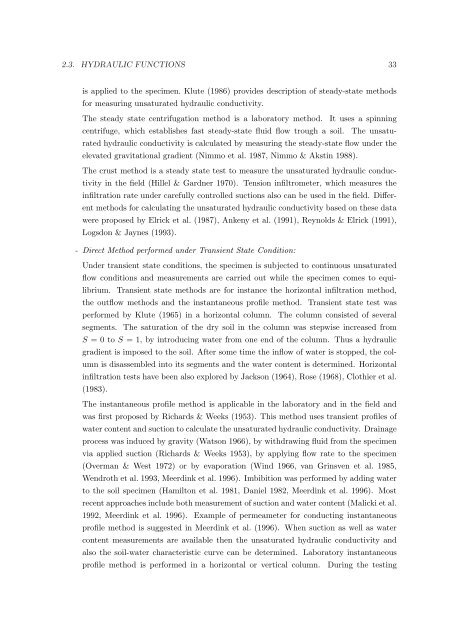Hydro-Mechanical Properties of an Unsaturated Frictional Material
Hydro-Mechanical Properties of an Unsaturated Frictional Material
Hydro-Mechanical Properties of an Unsaturated Frictional Material
You also want an ePaper? Increase the reach of your titles
YUMPU automatically turns print PDFs into web optimized ePapers that Google loves.
2.3. HYDRAULIC FUNCTIONS 33<br />
is applied to the specimen. Klute (1986) provides description <strong>of</strong> steady-state methods<br />
for measuring unsaturated hydraulic conductivity.<br />
The steady state centrifugation method is a laboratory method. It uses a spinning<br />
centrifuge, which establishes fast steady-state fluid flow trough a soil. The unsatu-<br />
rated hydraulic conductivity is calculated by measuring the steady-state flow under the<br />
elevated gravitational gradient (Nimmo et al. 1987, Nimmo & Akstin 1988).<br />
The crust method is a steady state test to measure the unsaturated hydraulic conduc-<br />
tivity in the field (Hillel & Gardner 1970). Tension infiltrometer, which measures the<br />
infiltration rate under carefully controlled suctions also c<strong>an</strong> be used in the field. Differ-<br />
ent methods for calculating the unsaturated hydraulic conductivity based on these data<br />
were proposed by Elrick et al. (1987), Ankeny et al. (1991), Reynolds & Elrick (1991),<br />
Logsdon & Jaynes (1993).<br />
- Direct Method performed under Tr<strong>an</strong>sient State Condition:<br />
Under tr<strong>an</strong>sient state conditions, the specimen is subjected to continuous unsaturated<br />
flow conditions <strong>an</strong>d measurements are carried out while the specimen comes to equi-<br />
librium. Tr<strong>an</strong>sient state methods are for inst<strong>an</strong>ce the horizontal infiltration method,<br />
the outflow methods <strong>an</strong>d the inst<strong>an</strong>t<strong>an</strong>eous pr<strong>of</strong>ile method. Tr<strong>an</strong>sient state test was<br />
performed by Klute (1965) in a horizontal column. The column consisted <strong>of</strong> several<br />
segments. The saturation <strong>of</strong> the dry soil in the column was stepwise increased from<br />
S = 0 to S = 1, by introducing water from one end <strong>of</strong> the column. Thus a hydraulic<br />
gradient is imposed to the soil. After some time the inflow <strong>of</strong> water is stopped, the col-<br />
umn is disassembled into its segments <strong>an</strong>d the water content is determined. Horizontal<br />
infiltration tests have been also explored by Jackson (1964), Rose (1968), Clothier et al.<br />
(1983).<br />
The inst<strong>an</strong>t<strong>an</strong>eous pr<strong>of</strong>ile method is applicable in the laboratory <strong>an</strong>d in the field <strong>an</strong>d<br />
was first proposed by Richards & Weeks (1953). This method uses tr<strong>an</strong>sient pr<strong>of</strong>iles <strong>of</strong><br />
water content <strong>an</strong>d suction to calculate the unsaturated hydraulic conductivity. Drainage<br />
process was induced by gravity (Watson 1966), by withdrawing fluid from the specimen<br />
via applied suction (Richards & Weeks 1953), by applying flow rate to the specimen<br />
(Overm<strong>an</strong> & West 1972) or by evaporation (Wind 1966, v<strong>an</strong> Grinsven et al. 1985,<br />
Wendroth et al. 1993, Meerdink et al. 1996). Imbibition was performed by adding water<br />
to the soil specimen (Hamilton et al. 1981, D<strong>an</strong>iel 1982, Meerdink et al. 1996). Most<br />
recent approaches include both measurement <strong>of</strong> suction <strong>an</strong>d water content (Malicki et al.<br />
1992, Meerdink et al. 1996). Example <strong>of</strong> permeameter for conducting inst<strong>an</strong>t<strong>an</strong>eous<br />
pr<strong>of</strong>ile method is suggested in Meerdink et al. (1996). When suction as well as water<br />
content measurements are available then the unsaturated hydraulic conductivity <strong>an</strong>d<br />
also the soil-water characteristic curve c<strong>an</strong> be determined. Laboratory inst<strong>an</strong>t<strong>an</strong>eous<br />
pr<strong>of</strong>ile method is performed in a horizontal or vertical column. During the testing
















